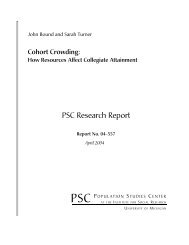Population Ageing and the Well-Being of Older Persons in Thailand ...
Population Ageing and the Well-Being of Older Persons in Thailand ...
Population Ageing and the Well-Being of Older Persons in Thailand ...
Create successful ePaper yourself
Turn your PDF publications into a flip-book with our unique Google optimized e-Paper software.
Section 3: Demographic, Social <strong>and</strong> Economic Pr<strong>of</strong>ile<br />
Figure 3.2 <strong>in</strong>dicates <strong>the</strong> mean number <strong>of</strong> liv<strong>in</strong>g<br />
children accord<strong>in</strong>g to respondents’ age <strong>and</strong> area <strong>of</strong><br />
residence. S<strong>in</strong>ce <strong>the</strong> source <strong>of</strong> <strong>the</strong>se data, <strong>the</strong> 2007<br />
Survey <strong>of</strong> <strong>Older</strong> <strong>Persons</strong>, also <strong>in</strong>cluded persons aged<br />
50-59, results for this age group are also provided <strong>in</strong><br />
order to represent persons who will be enter<strong>in</strong>g <strong>the</strong><br />
elderly ages dur<strong>in</strong>g <strong>the</strong> com<strong>in</strong>g decade. The steady<br />
rise <strong>in</strong> number <strong>of</strong> liv<strong>in</strong>g children with each successive<br />
five-year age group is a clear reflection <strong>of</strong> this past<br />
history <strong>of</strong> fertility decl<strong>in</strong>e <strong>in</strong> Thail<strong>and</strong>. Thus, persons<br />
age 50-54 average only a little over half <strong>the</strong> number<br />
for persons <strong>in</strong> <strong>the</strong>ir later seventies or older. The later<br />
start <strong>of</strong> fertility decl<strong>in</strong>e among residents <strong>in</strong> rural areas<br />
is reflected <strong>in</strong> <strong>the</strong>ir somewhat larger average number<br />
<strong>of</strong> children compared to urban residents. Never<strong>the</strong>less,<br />
it is clear that <strong>the</strong> past history <strong>of</strong> fertility decl<strong>in</strong>e<br />
will sharply affect family sizes <strong>of</strong> elderly <strong>in</strong> both rural<br />
<strong>and</strong> urban areas <strong>in</strong> <strong>the</strong> com<strong>in</strong>g years. Moreover this<br />
trend towards smaller families among future<br />
generations <strong>of</strong> older persons will cont<strong>in</strong>ue for at least<br />
some decades <strong>in</strong>to <strong>the</strong> foreseeable future, a po<strong>in</strong>t<br />
discussed fur<strong>the</strong>r below.<br />
The very dramatic changes that will occur <strong>in</strong> <strong>the</strong><br />
number <strong>of</strong> liv<strong>in</strong>g children that will characterize older<br />
aged women <strong>in</strong> Thail<strong>and</strong> <strong>in</strong> <strong>the</strong> near future is<br />
illustrated by comparisons between <strong>the</strong> situation <strong>in</strong><br />
2002 <strong>and</strong> projections for 2020 provided <strong>in</strong> Figure 3.3.<br />
In 2002, over 60 per cent <strong>of</strong> women age 60 <strong>and</strong> older<br />
had at least four liv<strong>in</strong>g children <strong>and</strong> only 23 per cent<br />
had two or fewer children. By 2020, when <strong>the</strong><br />
situation is virtually <strong>the</strong> reverse with only 60 per cent<br />
<strong>of</strong> women age 60 <strong>and</strong> older hav<strong>in</strong>g two or fewer<br />
children <strong>and</strong> only 20 per cent hav<strong>in</strong>g four or more<br />
liv<strong>in</strong>g children. Clearly <strong>in</strong> <strong>the</strong> com<strong>in</strong>g years <strong>the</strong>re will<br />
be fewer children available to co-reside <strong>and</strong> provide<br />
support to elderly parents <strong>in</strong> Thail<strong>and</strong>. How this will<br />
impact <strong>the</strong> well-be<strong>in</strong>g <strong>of</strong> <strong>the</strong> older population will<br />
depend on many o<strong>the</strong>r changes that will be occurr<strong>in</strong>g<br />
concomitantly. For example, if economic growth<br />
cont<strong>in</strong>ues, adult children will be f<strong>in</strong>ancially better <strong>of</strong>f<br />
<strong>and</strong> thus <strong>in</strong> a better position to provide material<br />
support. In addition, formal channels <strong>of</strong> f<strong>in</strong>ancial<br />
support <strong>in</strong>clud<strong>in</strong>g <strong>the</strong> government social security<br />
system <strong>and</strong> welfare allowances to older persons may<br />
broaden thus reduc<strong>in</strong>g dependency <strong>of</strong> <strong>in</strong>formal<br />
support from adult children. Thus <strong>the</strong> impact <strong>of</strong><br />
decl<strong>in</strong><strong>in</strong>g family size on <strong>the</strong> welfare <strong>of</strong> com<strong>in</strong>g<br />
generations <strong>of</strong> older persons <strong>in</strong> Thail<strong>and</strong> rema<strong>in</strong>s an<br />
open question but very important issue to monitor<br />
<strong>and</strong> <strong>in</strong>corporate <strong>in</strong> policy <strong>and</strong> programme responses<br />
to populations age<strong>in</strong>g.<br />
16















